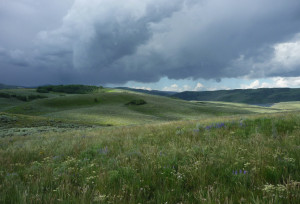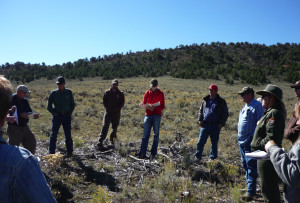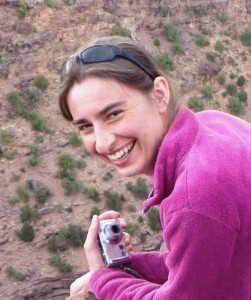By Lorien Belton for EDRblog.org
The greater sage-grouse give us the opportunity to find solutions in the midst of complexity.
Background

Greater sage-grouse, a chicken-sized bird which inhabits the vast sagebrush landscapes of the Western US, has become the posterchild for current debates over the Endangered Species Act. Its declining numbers over many decades have caused concern for many parties. Initially, that concern was primarily among biologists, who worried about the birds as well as what its declines meant more generally, as an indicator of widespread trends. As the years passed, though, more and more groups have become aware of, and concerned about, the bird’s status – each for their own reasons. The point is: lots of people are watching what happens in the sage-grouse world. And the more people who care, the more complex it is to find solutions that everyone finds acceptable.
My Role, as a Facilitator
I’m often up to my eyeballs in sage-grouse topics. I coordinate five of Utah’s ten “local working groups,” collaborative groups whose raison d’etre is to understand and help address sage-grouse issues. My role as facilitator is to coordinate logistics, make sure a wide variety of interests have a voice in the conversations, bring relevant science to the table as needed, and stay abreast of ever-changing policies. The latest news is a giant Environmental Impact Statement (15 of them, actually, across the West) completed by the Bureau of Land Management and the Forest Service. The Utah EIS is well over 1000 pages.
How, you might wonder, is it possible for anyone to muster the will to write that many pages about what to do, and what not to do, to keep sage-grouse wandering around in our sagebrush landscapes? And how could there possibly be that much to say in the first place?
The answer? It’s Complicated
By “it’s complicated” I don’t mean “oh, it’s really hard to explain, don’t worry about it.” What I mean is that the complexity of the situation is precisely why it takes so many pages to explain how to take care of what seems, at first glance, to be a chicken wandering around in the sagebrush. And that complexity is also why there is hope – or political will, if you like – to figure it out.
To start, there are LOTS of different threats to sage-grouse. Fire, drought, weeds, and changes like trees encroaching on sagebrush can affect habitat quality for nesting and raising chicks. People’s actions cause problems too, by breaking up the sagebrush landscape with energy development, ATV trails, etc. And, although sage-grouse evolved with natural predators, there are new ones (like red fox) that make it hard to raise chicks to adulthood. There are a lot of others, too. The point is: it’s really complicated.
To explore the complexity – and interconnectedness – of sage-grouse threats, here’s an example. A sage-grouse lives in an area that has seen a few years of drought. Recent fires – made worse by invasive cheatgrass – burned a lot of sagebrush, limiting the habitat available for nesting. Near a power line, she finally finds a good sagebrush with enough grass under it to hide her nest, and she lays her eggs. She’s got a good hiding spot, but one day an off-trail ATV rider zooms by and spooks her right off the nest. A raven, sitting on the power line, sees her leaving and swoops in for a snack. As a result, none of her chicks survive.
So who’s to blame? Many point to the predator. Others say it’s a habitat quality issue, and others blame recreationists or the power line. The point is, though, that there are a lot of things interacting. That makes it COMPLICATED. It means there’s not just one bad guy out there that can be singled out and chastised for causing sage-grouse declines.
An Opportunity for Collaboration

But there’s a REALLY good side to complexity. Again, no one person or group or impact is the bad guy. And that’s good, because who wants to come to the table with that label? Instead, you have a lot of opportunity because many folks are willing to come to the table and see what they can do to help. The complexity evens the playing field. Everyone is unfamiliar with something. Everyone has something to share and something to learn, and that’s where trust building starts.
The Utah Governor’s plan for sage-grouse conservation includes “opportunity areas,” places adjacent to existing sage-grouse habitat, which could someday become habitat. For example, if you cut down juniper trees that are expanding into sage-grouse habitat, grouse may start using those areas again. It’s a great way of thinking about making more habitat, not just preventing problems.
But what if we thought about how sage-grouse issues give us opportunities to build relationships, and solve problems together? Sage-grouse management can’t be addressed by one person or agency. The complexity of the sage-grouse problem demands that we collaborate.
Beyond Sage-Grouse
Working together – between agencies, private landowners, universities, and local governments – is critical for helping sage-grouse. But sage-grouse conservation is only the first place the benefits of collaboration are felt. Once people work together, they know whom to call when something else comes up. They know sage-grouse meetings are valuable because there will be other opportunities there, too – maybe to discuss another project after the meeting, or to finally meet that new agency employee you’ve been meaning to contact. In that way, the complexity of sage-grouse threats and the many stakeholders who wonder how an ESA listing would affect them, brings us together to seize opportunities.
We haven’t completely solved the sage-grouse conservation challenge yet. But the local working groups will keep chugging along, bringing their collective knowledge and relationships to bear on each of the challenges sage-grouse face. We design projects, ask research questions, and pool resources to identify and to address each threat appropriately. Day to day, as we watch the impact of our collective effort grow, we celebrate this opportunity.
 Lorien Belton works for Utah State University Extension as a facilitator for sage-grouse local working groups in the Uintah Basin, Morgan/Summit Counties, Carbon County, Strawberry Valley, and the West Desert.
Lorien Belton works for Utah State University Extension as a facilitator for sage-grouse local working groups in the Uintah Basin, Morgan/Summit Counties, Carbon County, Strawberry Valley, and the West Desert.
